You might not know Flagstaff sits at 7,000 feet and hosts one of the clearest night skies in the lower 48, perfect for stargazing and alpine walks. You’ll find ancient cliff dwellings, a living Route 66, volcanic caves, and ski slopes all within an easy drive, so planning a few days here rewards both outdoor thrills and quiet cultural stops. Keep going and I’ll map the 25 must-dos so you can pick what fits your pace.
Explore Walnut Canyon National Monument
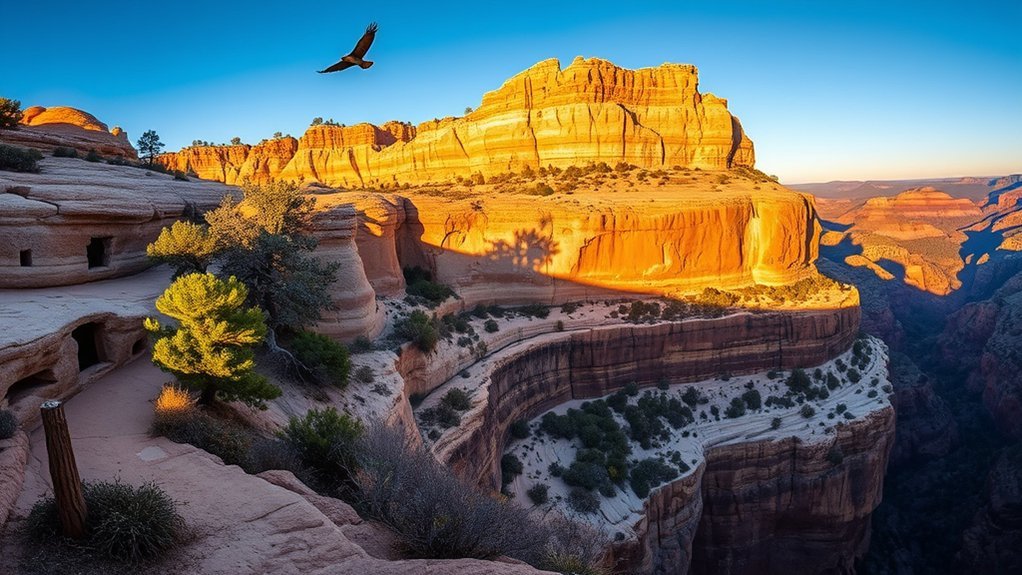
Step down into a striking slice of Arizona history at Walnut Canyon National Monument, where you’ll follow a rim trail and descend to see well-preserved Sinagua cliff dwellings tucked into sandstone alcoves. You’ll feel the canyon’s cool hush as you wind along switchbacks, passing interpretive signs that explain ancient lifeways, masonry techniques, and the seasonal rhythm that shaped habitation. Pause on ledges to study small, rectangular rooms and communal spaces built into the rock face, imagining families tending crops on mesa tops above. Look for juniper and pinyon pines clinging to steep slopes, and listen for scrub jays and ravens that patrol the skies. You’ll find the Island Trail offers close-up views while the Rim Trail provides sweeping panoramas of the canyon’s layered bands. Wear sturdy shoes, bring water, and plan for varying elevation. Whether you’re a history buff, photographer, or casual hiker, Walnut Canyon delivers a compact, immersive encounter with the region’s archaeological and natural heritage.
Hike Humphreys Peak
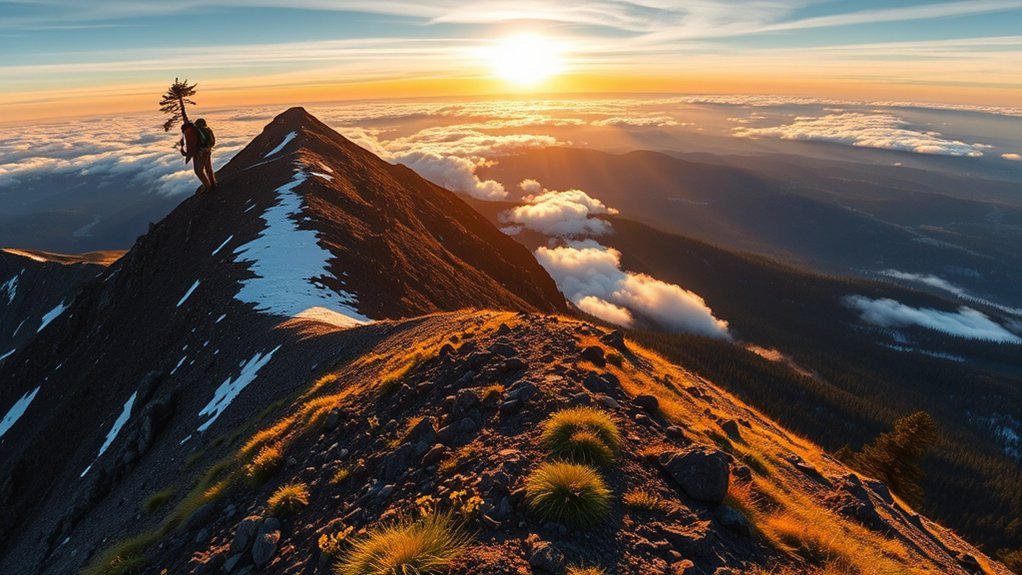
Tackle Humphreys Peak for the tallest, most rewarding hike in northern Arizona—this 12.6-mile out-and-back trail climbs to 12,633 feet and rewards you with alpine tundra, panoramic views of the San Francisco Peaks, and a real sense of summit accomplishment. You’ll start in cool Ponderosa forest, switchback through mixed conifers, then enter rocky, exposed terrain where altitude and weather matter. Move at a steady pace, take frequent short breaks, hydrate, and watch for changing conditions—storms can roll in fast. Trail footing gets loose and steep near the summit, so trekking poles and sturdy shoes help. Wildlife sightings are possible but distant; respect fragile tundra and stay on trail. If you want sunrise or sunset colors, plan carefully and bring a headlamp for the dark stretches. Allow 6–8 hours round-trip depending on fitness and acclimation. Check trail status and permits in high season, and turn back if conditions or your breathing tell you to—summit attempts reward preparation, not risk.
Visit Lowell Observatory
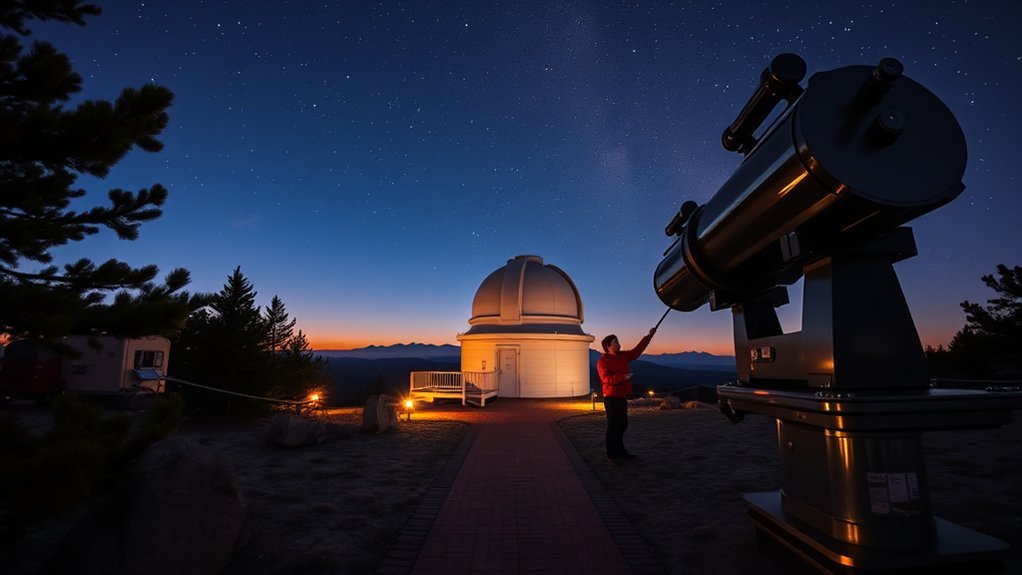
Head to Lowell Observatory to stand where Pluto was first spotted and feel the weight of astronomical history. You can use public telescopes and join guided programs that put planets, nebulae, and star clusters into sharp view. Stick around for night sky events and special talks that’ll deepen your appreciation of the cosmos.
Historic Pluto Discovery
Wander through Lowell Observatory and you’ll stand where Clyde Tombaugh uncovered Pluto in 1930, surrounded by historic telescopes and crisp Arizona skies that still inspire discovery. You’ll trace the steps of careful observation: the darkroom work, the blink comparator that revealed a moving dot, and the meticulous notes that confirmed a new world. Exhibits display Tombaugh’s original plates, letters, and contextual artifacts that explain why this faint object mattered. You’ll learn how photographic techniques evolved, how debates about classification unfolded, and why the discovery reshaped planetary science. Guided signage and museum staff fill gaps with engaging stories, so you leave appreciating both the human patience behind discovery and the observatory’s continuing role in unraveling the solar system’s mysteries.
Public Telescope Programs
Often evenings at Lowell Observatory turn into hands-on stargazing sessions where you get to look through historic and modern telescopes alike, guided by knowledgeable staff who explain what you’re seeing and why it matters. You’ll join small groups, peer through iconic instruments, and learn observing techniques that make distant worlds feel close. Staff point out planets, nebulae, and star clusters, tailoring explanations to your curiosity. Programs change seasonally, so you’ll often encounter different targets and demonstrations. Practical tips: arrive early, bring a jacket, and ask questions—guides love to share context about each instrument’s history and capability.
| Program | Telescope Type | Typical Targets |
|---|---|---|
| Public Viewing | Historic refractor | Planets, Moon |
| Guided Tours | Modern reflector | Deep-sky objects |
| Family Sessions | Portable scopes | Double stars, clusters |
Night Sky Events
After soaking in hands-on stargazing and peering through historic instruments, plan to time your visit for one of Lowell Observatory’s night sky events—special evenings that spotlight seasonal phenomena, guest speakers, and guided observing sessions. You’ll arrive as the sky darkens to hear astronomers explain current targets—planets, nebulae, meteor showers, or occultations—then move to telescopes calibrated for crisp views. Events often include multimedia presentations, Q&A with researchers, and opportunities to photograph celestial sights with staff guidance. Tickets vary by program, so book early for limited-capacity sessions like summer star parties or rare-conjunction nights. Whether you’re a novice or an enthusiast, these curated evenings sharpen your sky knowledge, deepen appreciation for local dark-sky protections, and deliver unforgettable views.
Wander Historic Downtown and Route 66
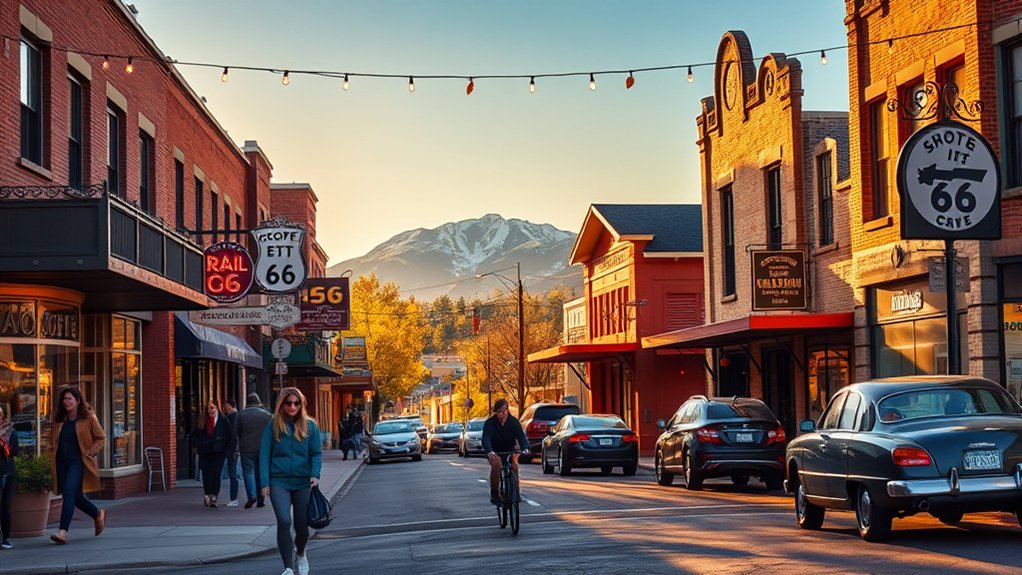
Step onto Flagstaff’s Historic Downtown and you’ll find a lively stretch of preserved brick storefronts, neon signs, and Route 66 nostalgia that invites exploration; you can duck into indie shops, sit for a coffee while watching vintage cars roll by, and read plaques that tell the town’s railroad-and-roadside history. Stroll the walkable blocks to admire restored façades, murals, and classic neon—each storefront has a story, from early railroad commerce to 20th-century roadside culture. Pop into bookstores, galleries, and bakeries; friendly shopkeepers will point out historic markers and local lore. Don’t miss the Route 66 memorabilia and photo ops at the iconic signage. Weekends bring farmers markets, live music, and street performers that animate the square. If you want a focused experience, follow a self-guided Route 66 walking map to spot historic hotels, old gas stations, and plaques noting significant events. Wander at your pace—this compact district rewards curiosity and a slow, observant walk.
Drive the Scenic Old Walnut Canyon Loop
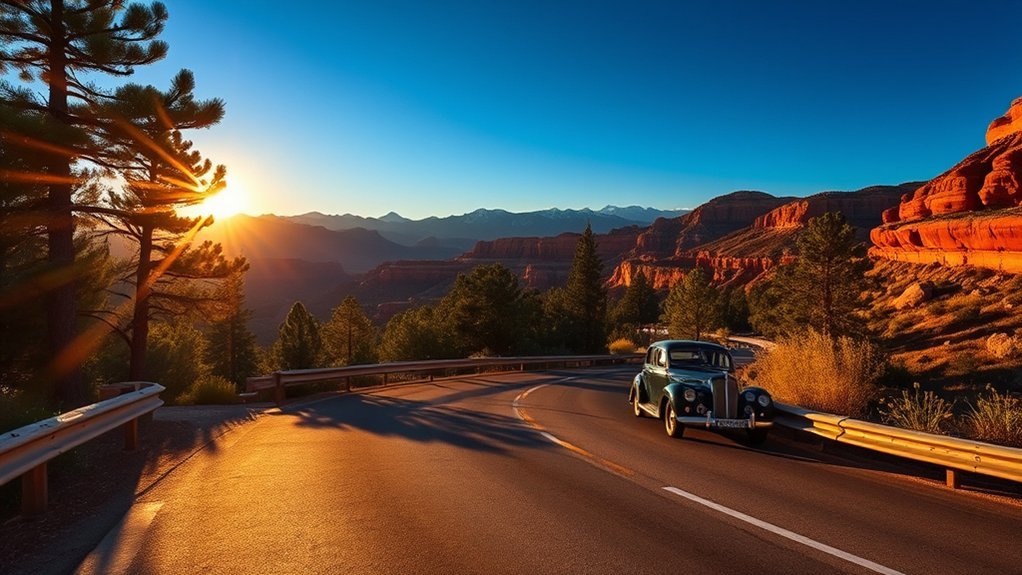
Hop in and follow the Old Walnut Canyon Loop for a compact scenic drive that highlights red-rock formations, Ponderosa pines, and sweeping canyon views. You’ll find well-marked pullouts where you can stop for photos, short walks, and a closer look at ancient cliff dwellings from safe vantage points. Time your drive for golden hour to make the colors pop and avoid mid-day crowds at the busiest overlooks.
Route Highlights
If you’re looking for a short, scenic drive that mixes towering ponderosas, red-rock overlooks, and easy access to hiking, the Old Walnut Canyon Loop delivers—winding quietly through forested ridges with several pullouts that make great photo stops and picnic spots. As you follow the loop, note the gradual elevation changes that reveal different plant communities and sweeping views of Walnut Canyon’s carved cliffs. The road’s gentle curves let you savor unexpected glimpses of juniper-studded mesas and distant San Francisco Peaks. Mile markers point to trailheads where short hikes drop into shady alcoves or rise to panoramic benches. Wildlife sightings—elk, mule deer, and songbirds—are common at dawn and dusk. The pavement is well maintained, making the route accessible for most vehicles.
Scenic Pullouts
As you follow the Old Walnut Canyon Loop, the scenic pullouts invite you to pause and take in the landscape: wide overlooks frame the red cliffs and distant San Francisco Peaks, discreet picnic areas tuck beneath ponderosa pines, and small parking bays give easy access to short interpretive trails. You’ll step out, breathe high-desert air, and scan layers of sandstone and juniper while raptors wheel overhead. Each stop offers a different perspective—sunlit hoodoos, shadowed alcoves, or panoramic valley views—so plan short intervals to wander, photograph, and learn from the kiosks. Timing matters; dawn and late afternoon cast the best light and cooler temperatures.
| Pullout | Feature | Ideal Time |
|---|---|---|
| Overlook A | Panoramic view | Sunset |
| Picnic Grove | Shaded tables | Midday |
| Trailhead B | Short interpretive loop | Morning |
| Cliff Edge | Hoodoo close-up | Golden hour |
Tour Wupatki National Monument
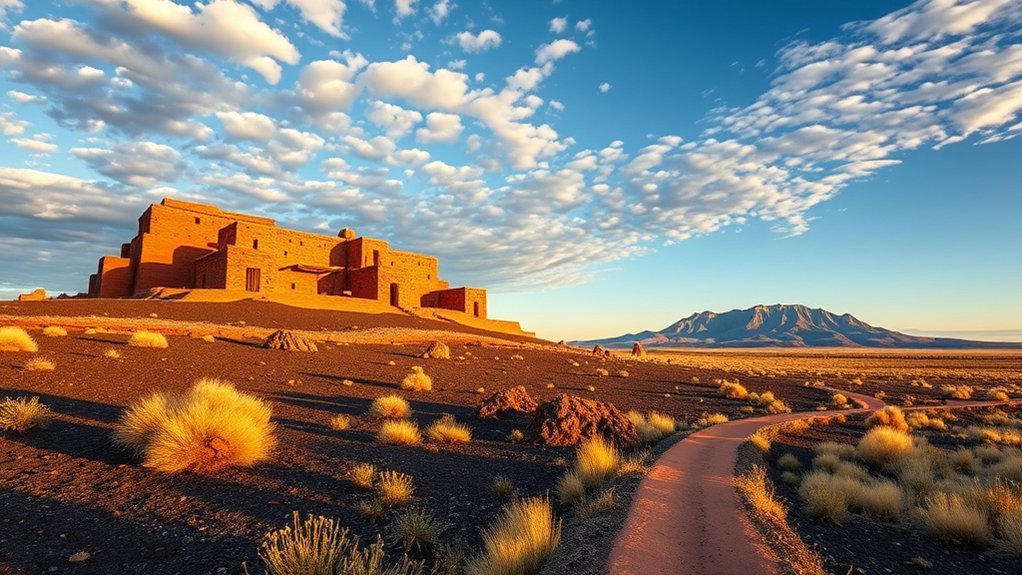
Drive out onto the high desert and you’ll step into Wupatki National Monument, where towering sandstone pueblos and sweeping views tell stories of ancient communities that thrived here centuries ago. You’ll follow easy trails between multiroom ruins—Wupatki Pueblo’s twenty-plus rooms, the Hawk House, and the Box Canyon sites—each with interpretive signs that explain construction techniques, trade networks, and daily life. Bring sun protection and water; the landscape is exposed and deceptively dry. Time your visit for morning or late afternoon light, when shadows carve the architecture and colors deepen for photos. Rangers offer insight during scheduled talks and can point out lesser-known features like ball courts and petroglyph panels. You’ll feel the scale of this former regional hub and understand how people adapted to scarce resources here. Leave no trace, respect fragile masonry, and use designated paths to help preserve these ruins for future visitors who’ll come to imagine lives lived in this striking, wind-swept place.
Walk the Lava River Cave
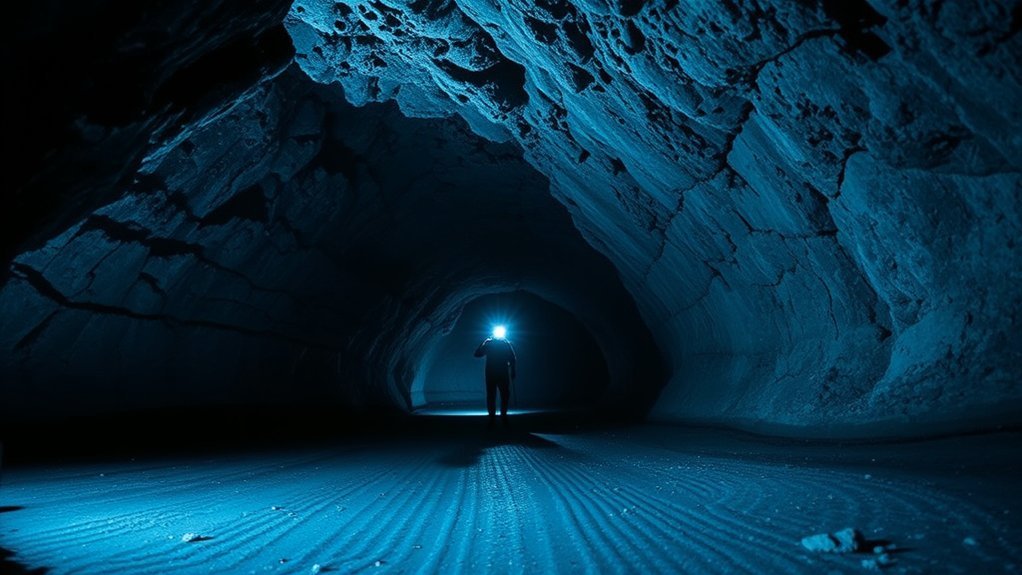
You’ll find the Lava River Cave trailhead just off Highway 89A with a short walk to the fenced entrance and numbered permit box. Once inside the cool, 700-foot lava tube you’ll see smooth pahoehoe floors, jagged ceiling formations, and tight squeezes that reveal volcanic history. Bring sturdy shoes, a warm layer, and at least two reliable light sources, and watch your step—parts are uneven and can be slippery.
Cave Access & Trailhead
Head down the short trail from the parking area and you’ll find the unassuming mouth of the Lava River Cave—an easy-to-miss opening in a field of lava rocks that leads into a 17-mile long tube carved by an ancient flow. The trail is well-marked but uneven; wear sturdy shoes and expect loose volcanic gravel. A signed information kiosk explains seasonal closures and safety rules; check it before you enter. Parking is limited—arrive early on weekends or holidays. The approach crosses open tundra with low shrubs and wide sky, so bring sun protection and water. Pets aren’t allowed in the cave, and cell service is spotty, so plan logistics and companions before you descend.
Inside the Lava Tube
Once you step into the mouth of the Lava River Cave, the temperature drops and the light shrinks to a narrow ribbon behind you—so switch on your headlamp before moving deeper. You’ll follow a winding corridor carved by ancient flows, walls glossed with black volcanic glass and textured with ripples and shelves. Stalactites and delicate soda straws hang from the ceiling in places where mineral-rich water once dripped. The passage alternates between roomy chambers and low squeezes that force you to crouch; each turn reveals new shapes, a basalt bench, a collapsed skylight, or a sudden pool of mud. Keep your pace steady to appreciate the cave’s quiet scale, note the echo of your footsteps, and respect the fragile formations as you explore.
Safety & Gear Tips
Because the cave stays cool and dark year-round, bring layered clothing and reliable lighting before you go in. You’ll want a headlamp plus a backup flashlight with fresh batteries; hands-free light keeps you steady on uneven ground. Wear sturdy boots with good tread—rocks can be slippery and ankle-twisting is common. Gloves protect your palms while scrambling; long pants shield knees from rough lava rock. Tell someone your plan and estimated return time; cell service can be spotty. Stay on marked paths, avoid touching delicate formations, and don’t block narrow passages for others. If you’re claustrophobic or have mobility issues, consider skipping tight sections. Pack water, a small first-aid kit, and respect posted rules to keep yourself safe.
Stroll Through the Arboretum at Flagstaff
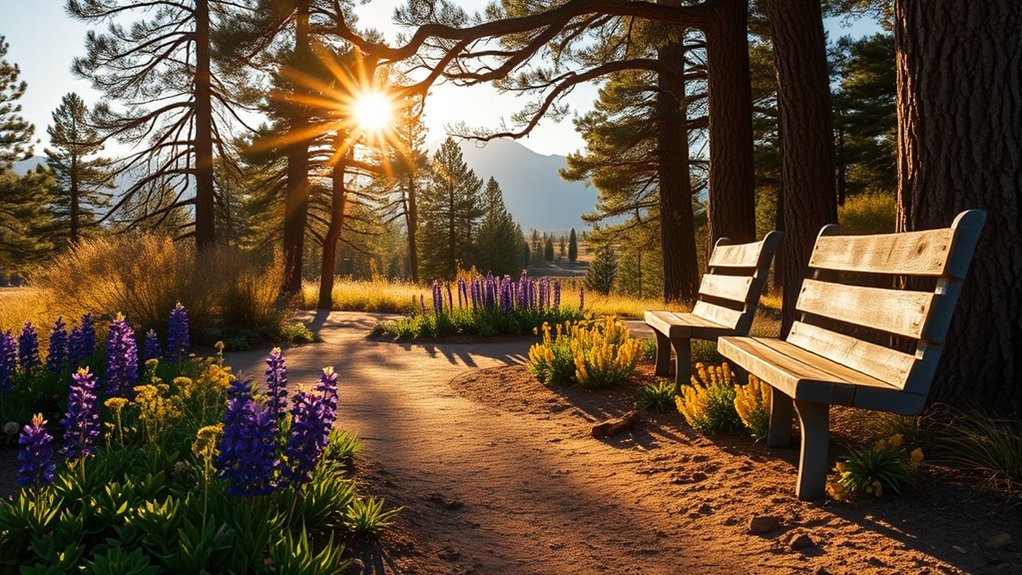
Often you’ll find the Arboretum at Flagstaff a peaceful pocket of high‑desert life where native pines, aspens and wildflowers mingle along shaded trails. You’ll stroll winding paths, learn about regional ecology from interpretive signs, and spot songbirds flitting through cottonwoods. The elevation keeps summer temperatures pleasant, and spring brings vivid wildflower displays. You can time your visit for guided walks or self‑guided exploration, photographing lichens on ponderosa bark and noticing how understory plants change with the seasons. Trails are well maintained and suitable for most fitness levels, though shoes with traction help on steeper sections. Bring water, a field guide, and a camera to make the most of the experience.
- Follow the Creekside and Aspen Loop for varied scenery and easy terrain.
- Join a docent walk to learn about native plant restoration and fire ecology.
- Visit the native plant nursery to see species used in regional conservation and landscaping.
Ski or Snowboard at Arizona Snowbowl
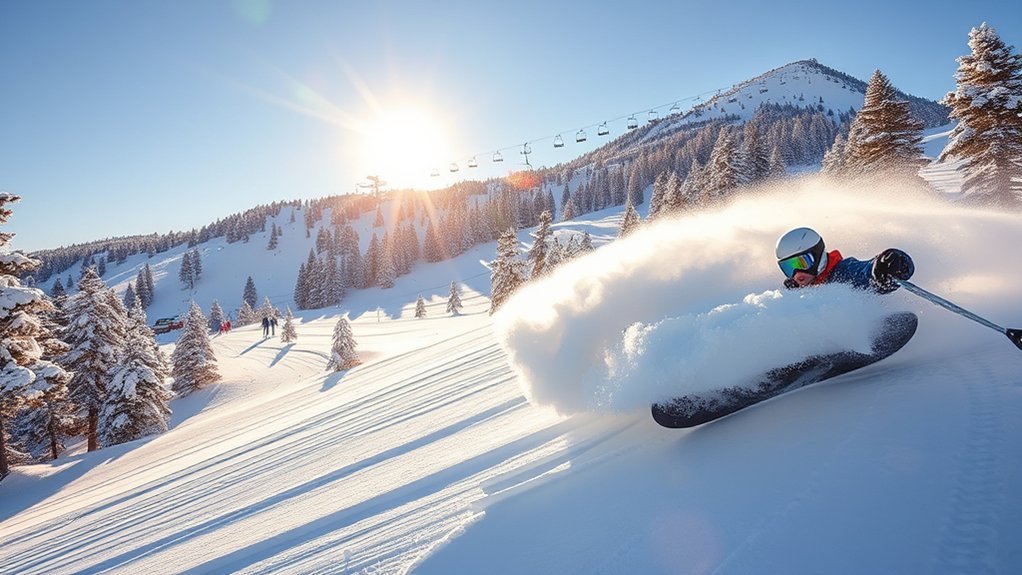
If you’re craving alpine runs without leaving northern Arizona, Arizona Snowbowl delivers steep groomers, gladed tree trails, and sweeping views of the San Francisco Peaks that make each descent memorable. You’ll find terrain for every skill level: cruisers and beginner zones near the base, intermediate cruisers on wide blue runs, and black-diamond chutes and exposed ridgelines for advanced skiers and boarders. Lift service is efficient, with scenic chairlift rides that showcase aspens and volcanic rock. Rentals, lessons, and guided clinics are available if you need gear or want to improve technique. Snowmaking and grooming keep key runs consistent late into the season, and the elevation provides reliable snowfall compared with lower deserts. Pack layers — conditions can change quickly at 11,500 feet — and bring sunscreen for high-altitude sun. Après options at the lodge offer hot drinks and relaxed views. Whether you carve powder or practice turns, Snowbowl gives you a distinctive Rocky Mountain–meets-desert skiing experience.
Discover Sunset Crater Volcano National Monument
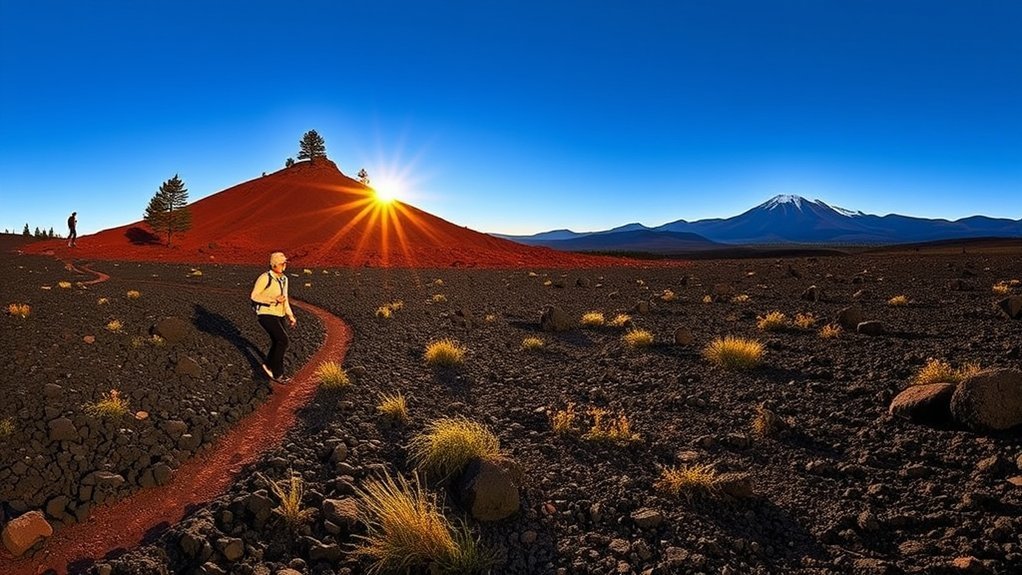
After a day on the slopes, swap skis for hiking boots and head east to Sunset Crater Volcano National Monument, where a relatively recent volcanic eruption reshaped the landscape into a stark, otherworldly playground. You’ll feel the raw power of lava flows and cinder fields beneath your feet as you follow marked trails that wind around crater rims and through blackened forests. Interpretive panels explain the 11th-century eruption, its effect on local ecosystems, and the way human communities adapted.
- Hike the Lava Flow Trail for close-up views of cinder cones and basalt fields.
- Walk the Crater Trail loop to stand on the rim and gaze across rippled volcanic terrain.
- Visit the visitor center to learn geology, see exhibits, and plan guided ranger programs.
Bring layers, water, and good shoes — shade’s limited. Sunset light turns the cinders crimson; it’s a short, unforgettable step into geological history.
Bike the Flagstaff Urban Trails System (FUTS)
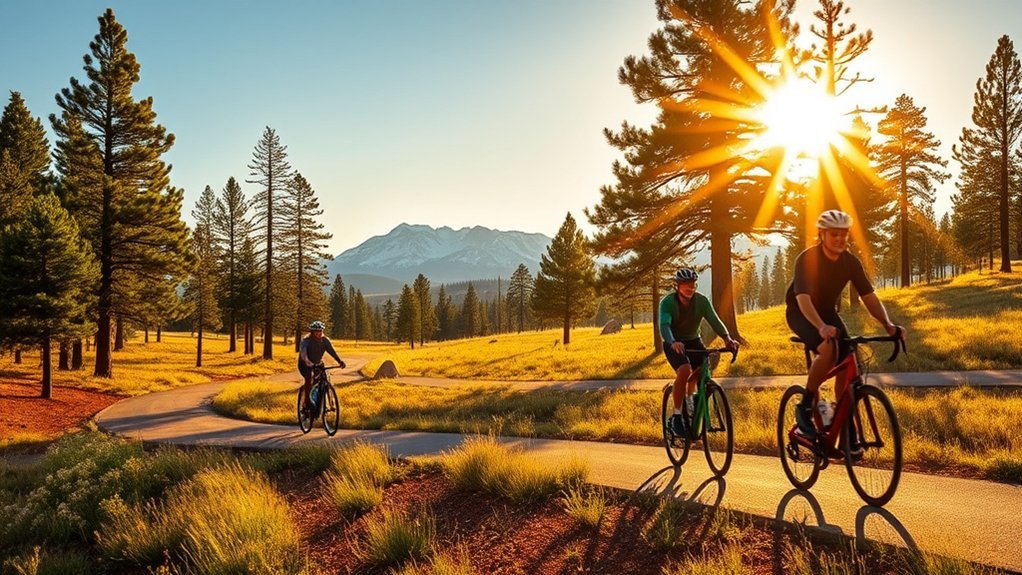
You can explore more than 50 miles of paved and soft-surface trails on the Flagstaff Urban Trails System (FUTS), which link parks, neighborhoods, and downtown. Try popular stretches like the Buffalo Park loop and Rio de Flag Greenway for scenic views and easy access to coffee stops. Ride with common-sense safety—announce passes, keep right, and wear a helmet—to enjoy the network respectfully and confidently.
Trail Network Overview
Because Flagstaff’s Urban Trails System (FUTS) links parks, neighborhoods, and downtown, it’s one of the easiest ways to explore the city by bike. You’ll find over 50 miles of paved, multiuse trails weaving through ponderosa pines, along washes, and past local landmarks, all designed for safe, car-free travel. The network’s signage keeps you oriented, surfaces stay well maintained, and trailheads offer bike parking and maps so you can ride with confidence. Whether you want a short spin or a longer pedal, the FUTS lets you connect neighborhoods, transit, and green spaces without backtracking.
- Connectivity: seamless links between destinations for point-to-point trips.
- Accessibility: gentle grades and paved surfaces for most riders.
- Maintenance: clear signage and regular upkeep for safe riding.
Popular Route Highlights
Now that you know how the FUTS connects neighborhoods and sights, let’s look at a few standout routes you’ll want to pedal. Start with the Rio de Flag corridor: it’s flat, fast, and threads through downtown, giving you coffee shops, breweries, and historic districts within easy reach. For scenery, take the Flagstaff Urban Trail toward Buffalo Park — the loop offers aspen groves, wide meadow views, and a great hill climb if you want a workout. To experience woodlands and quieter miles, ride the Flagstaff Ranch connector into ponderosa pines; birdwatching and shaded stretches make it peaceful. Finally, try the Sunnyside path to reach the Observatory area at sunset, where long vistas reward your effort and timing.
Safety and Etiquette
When you pedal the FUTS, stay aware and courteous so everyone — walkers, runners, families with strollers, and fellow cyclists — can enjoy the trail safely; follow posted speed limits, announce passes with a friendly “On your left,” and slow down in crowded or blind spots. Observe signage, yield to pedestrians, and treat trail intersections like road crossings. Keep right unless passing, use lights and reflective gear at dusk, and secure gear to prevent spills. If you stop, move off the trail to the side. Respect wildlife and private property by staying on designated paths. Carry water, a basic repair kit, and ID.
- Wear a helmet and visible clothing.
- Signal intentions and pass courteously.
- Pack out trash and respect others.
Explore Museum of Northern Arizona
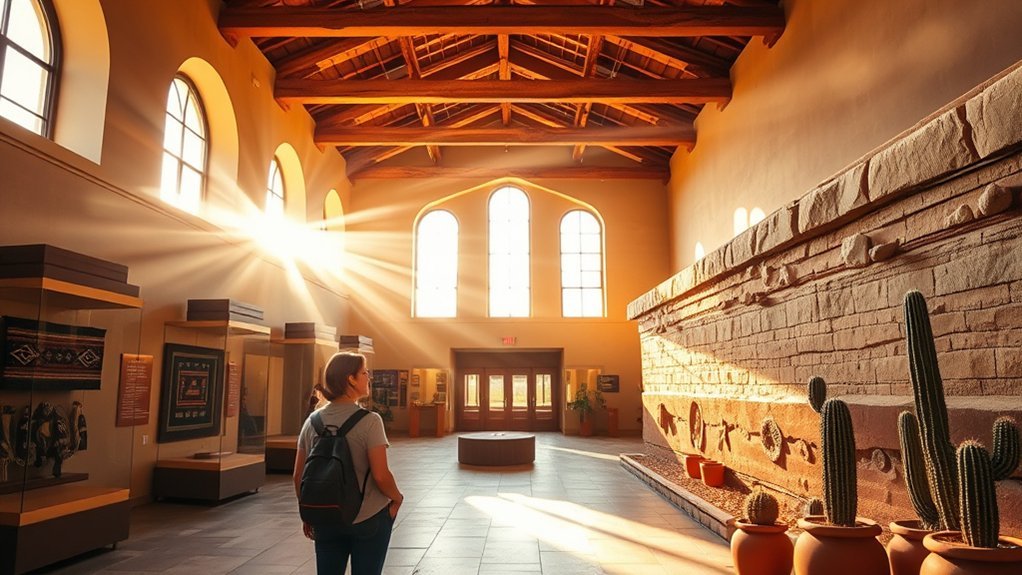
Curious about the cultural heartbeat of northern Arizona? You’ll find it at the Museum of Northern Arizona, where exhibits blend Native American art, regional natural history, and scientific research. Walk through galleries showcasing Hopi katsina carvings, Navajo textiles, and ancestral pottery—labels explain symbolism and techniques so you leave with context, not just admiration. The museum’s geology and paleontology displays highlight Colorado Plateau formations and fossil finds, helping you connect landscapes you’ve seen around Flagstaff to deep time. Don’t miss the rotating exhibits and special lectures; they bring contemporary scholarship and community voices into focus. Outside, the sculpture garden and interpretive trails offer a quieter way to reflect on art and environment. Friendly staff and a well-stocked shop make planning easy—check the calendar for workshops or guided tours. Whether you’re keen on Indigenous cultures, earth science, or thoughtful curation, the museum rewards curiosity and enhances your understanding of this remarkable region.
Take a Day Trip to Sedona via Oak Creek Canyon
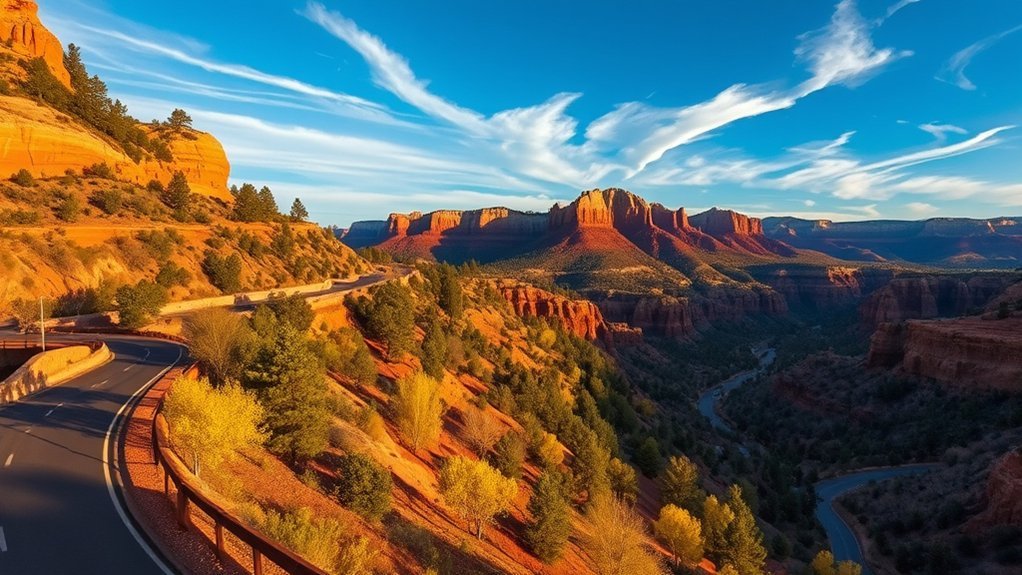
Take the scenic drive through Oak Creek Canyon and you’ll feel the landscape shift from ponderosa pine and volcanic ridgelines to jaw-dropping redrock walls that frame Sedona’s famous spires. You’ll want to stop often: pullouts offer creekside picnics, short hikes, and viewpoints where light turns sandstone into glowing oranges and deep crimsons. The road itself is part of the attraction—tight turns, shaded canyons, and sudden vistas keep you alert and delighted.
Drive Oak Creek Canyon for shifting forests, sudden redrock vistas, creekside pullouts, and sunset-lit sandstone that stops you in your tracks
Plan your timing to avoid midday crowds and catch golden hour for photos. Pack water, layers, and sturdy shoes; weather and elevation change quickly. If you’re tempted, explore a brief trail (Cathedral Rock, Bell Rock base) or stroll through Sedona’s galleries and cafés before heading back to Flagstaff.
- Scenic pullouts and picnic spots
- Short hikes with high payoff views
- Sedona dining, shops, and photo stops
Attend a Live Show at Orpheum Theater
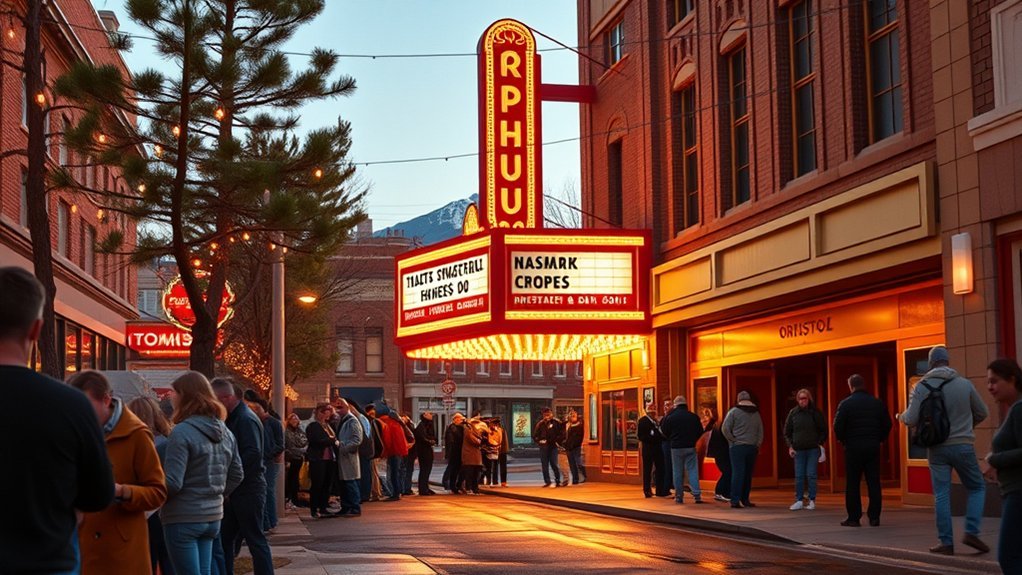
After a day of red-rock sunsets and canyon drives, head back into Flagstaff’s historic downtown to catch a live show at the Orpheum Theater, a beautifully restored 1911 venue that still hums with old-school charm. You’ll step into plush seats beneath ornate plasterwork and a glowing marquee, where acoustics and sightlines make every performance feel intimate. Check the theater’s schedule before you go—Orpheum hosts touring bands, stand-up comedians, film nights, and local dance or theater troupes—so you can pick an evening that matches your mood. Arrive early to browse lobby art, snap photos of the vintage lobby, and grab a program. The staff are friendly and knowledgeable; they’ll help with seating and accessibility needs. After the curtain, linger outside under string lights to compare notes with fellow attendees or wander nearby for a late snack. A night at the Orpheum is a warm, authentic way to experience Flagstaff’s cultural heartbeat.
Sample Local Brews on the Flagstaff Ale Trail
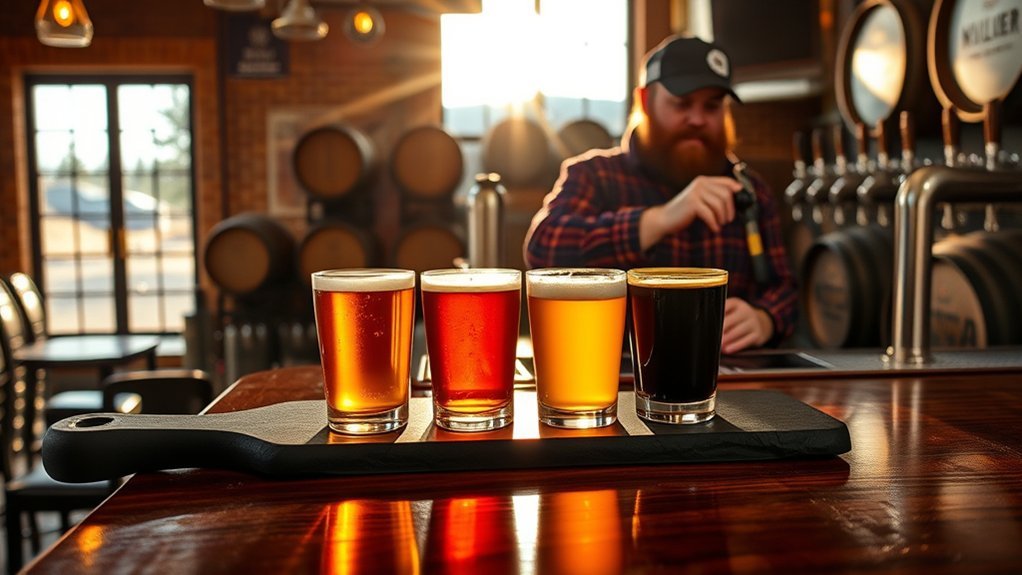
Hit the Flagstaff Ale Trail to sample popular local breweries like Historic Brewing and Mother Road—each offers distinct house styles and rotating taps. Ask for a tasting flight to compare flavors side-by-side and pace yourself with water between pours. Pair sharp cheddars, spicy sausages, or wood-fired pizzas with different brews to see which combinations sing.
Popular Local Breweries
A handful of Flagstaff breweries pack big personality into cozy taprooms and sunlit patios, and you’ll find everything from crisp pilsners to smoky barrel-aged stouts along the Ale Trail. You can wander between family-run spots and experimental brewpubs, chatting with brewers who love to tweak hops, yeast, and oak. Look for seasonal releases, food pairings, and outdoor seating that makes sampling feel like a small-town celebration.
- Lumberyard Brewing Co. — rustic patio, balanced ales, rotating small-batch taps.
- Mother Road Brewing Co. — lively taproom, Belgian-influenced beers, pizza-friendly menu.
- Beaver Street Brewery — intimate vibe, bold stouts, community-focused events.
These stops give you a true taste of Flagstaff’s craft beer scene.
Tasting Flight Tips
Start your tasting flight by asking the bartender for a sampler board and a quick rundown of what’s on tap — it’ll help you map flavors and pacing before you sip. Move from lighter to darker beers to notice subtle shifts: pilsners and saisons first, then pale ales, IPAs, ambers, and finally stouts. Take small sips, hold briefly to register aroma, and note temperature changes as beers warm — aromatics open up. Cleanse your palate with water between pours and pause long enough to compare two similar styles. Ask about seasonal or experimental pours; brewers often rotate limited releases that show local creativity. Jot quick notes on favorites so you can find them later on the Flagstaff Ale Trail.
Pairings and Bites
When you follow the Flagstaff Ale Trail, pairings can transform a flight into a mini feast—think crisp pilsners with citrusy ceviche, malty ambers alongside smoked brisket sliders, and roasty stouts matched to chocolatey desserts or blue cheese. You’ll discover how local breweries craft menus to highlight texture and balance: acidic beers cut richness, hoppy ales lift spice, and fuller-bodied brews stand up to charred meats. Taste deliberately—note finish, mouthfeel, and lingering flavors. Ask servers for suggested bites or order a shared board to compare contrasts. Use small bites between sips to reset your palate and identify favorite combos to recreate at home or bring to your next picnic on the Coconino Plateau.
- Start with bright, citrusy pairings
- Match weight to weight
- Finish with dessert or blue cheese
Visit Riordan Mansion State Historic Park
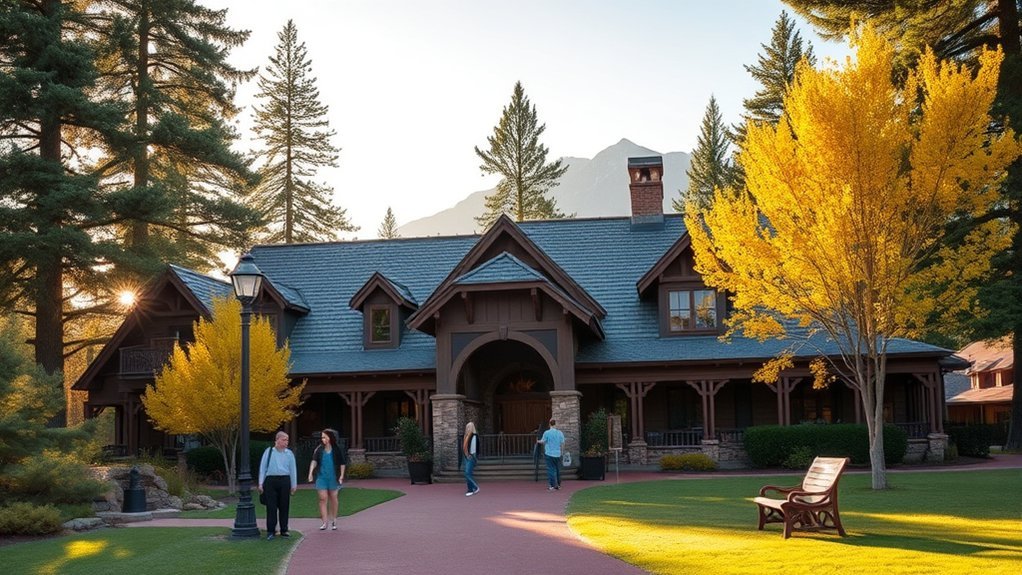
Step inside Riordan Mansion State Historic Park and you’ll be transported to early 20th-century Flagstaff, where two matching Arts and Crafts-style homes tell the story of a prominent local family and their deep ties to the lumber and railroad industries. You’ll follow guided tours through handcrafted woodwork, stained glass, and original furnishings that showcase Prairie School influences and an emphasis on natural materials. Guides point out clever built-ins, period lighting, and the mansion’s adaptive design for Arizona’s climate, giving context about daily life, social gatherings, and the Riordans’ civic roles. Outside, manicured grounds and ponderosa pines frame mountain views and invite a reflective stroll along interpretive trails. You can photograph architectural details from permitted angles, consult exhibits in the visitor center, and pick up thoughtful souvenirs or local history books. Whether you’re a design enthusiast, history buff, or curious traveler, the site offers a compact, well-interpreted glimpse into Flagstaff’s formative years.
Go Stargazing at Mars Hill / Lowell Observatory Programs
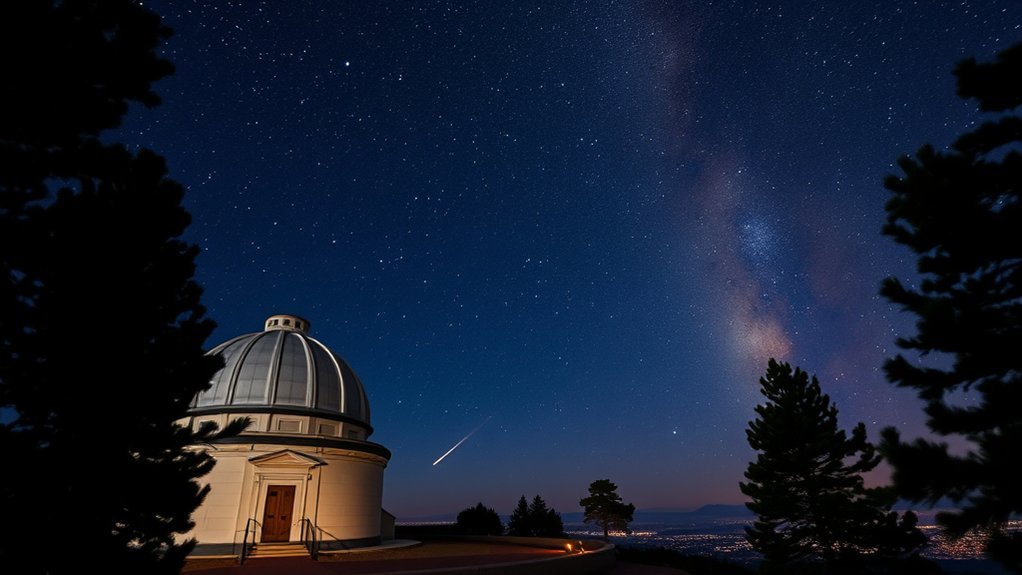
Often on clear nights you’ll find locals and visitors gathering atop Mars Hill, home to the historic Lowell Observatory, where guided programs introduce you to planets, nebulae, and the story of Pluto’s discovery. You’ll hear enthusiastic guides narrate the night sky, point out constellations, and explain how telescopes reveal faint galaxies and star-forming regions. Programs vary — from lecture-style talks to telescope viewings — so you can pick something that fits your curiosity and schedule. Dress warmly; Flagstaff nights get chilly, and you’ll want steady hands for binoculars or camera gear. Accessibility options and family-friendly events make it easy to bring kids or friends. Tickets often sell out for special events, so reserve ahead. After an evening under brilliant stars, you’ll leave with a map of what you saw, new questions, and a deeper appreciation for astronomy.
- Guided telescope viewing for close-up planetary and deep-sky looks
- Evening talks on astrophysics and Lowell’s history
- Family-friendly and special event programs
Paddle or Fish at Mormon Lake
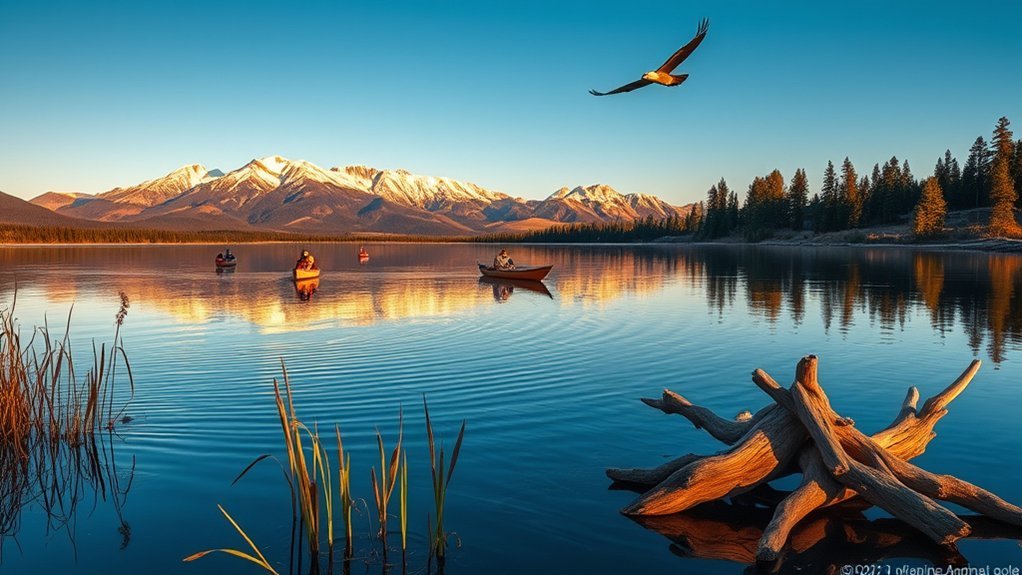
After a night under the stars at Lowell, head east to Mormon Lake for a very different kind of sky—wide, blue, and mirrored in placid water. You’ll find a serene, high-elevation oasis where ponderosa and aspen frame a shallow lake that changes with the seasons. Rent a kayak, canoe, or paddleboard from local outfitters and glide across lily pads and tule reeds, watching waterfowl and dragonflies skim the surface. If you prefer fishing, shore and boat anglers pursue stocked trout and native species; bring light tackle, polarized sunglasses, and a valid Arizona fishing license. Mornings offer glassy conditions and dramatic light; afternoons can bring breeze and wildlife activity. Paths around the lake are short and accessible, perfect for stretching between casts or paddles. Pack water, sun protection, and a camera—the reflections and quiet make for unforgettable photos. Check local conditions first, since water levels vary, and respect private campsites and fragile shoreline habitat.
Hike the Kelsey Trail to Fat Man’s Loop
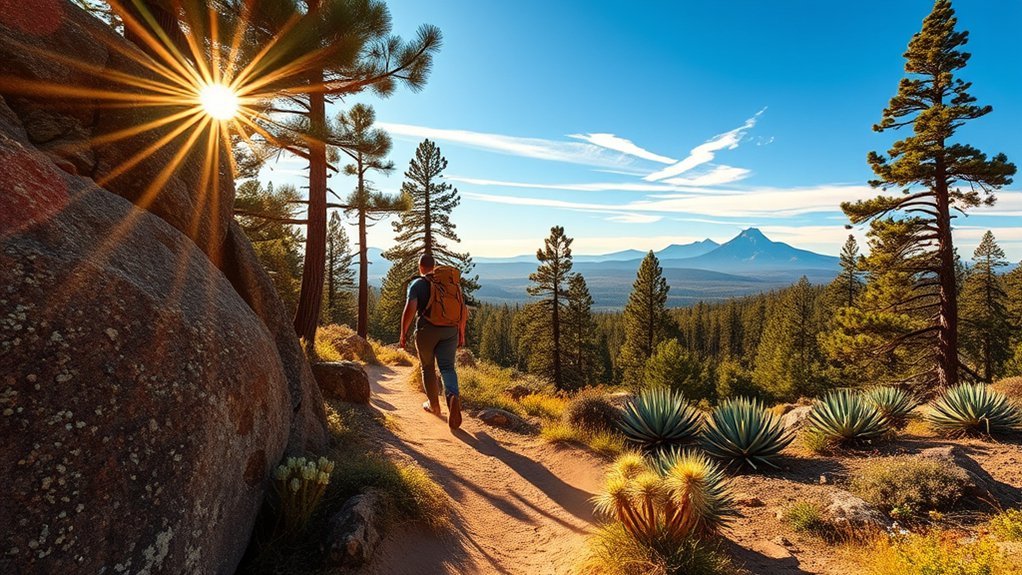
Winding through shaded ponderosa and sunlit clearings, the Kelsey Trail leads you to the quirky rock formations of Fat Man’s Loop in a compact, rewarding hike. You’ll follow a well-marked path that gains gentle elevation, with cool forest scent and scattered meadows breaking the canopy. The loop itself frames hoodoos and balanced rocks that invite careful scrambling and great photo angles without technical climbing. Expect varied footing—packed soil, occasional roots, and loose gravel—so wear grippy shoes and bring water. In spring and early summer, wildflowers brighten the trail; in fall, the aspens whisper gold.
- Trail basics: ~1.5–2 miles round-trip, moderate difficulty, family-friendly with short steeper sections.
- What to bring: water, layered clothing, sun protection, camera, small first-aid kit.
- Best tips: start early for cooler temps, stick to the loop to protect fragile formations, and enjoy quiet observation rather than moving rocks or graffiti.
Experience Native American Cultural Events and Markets
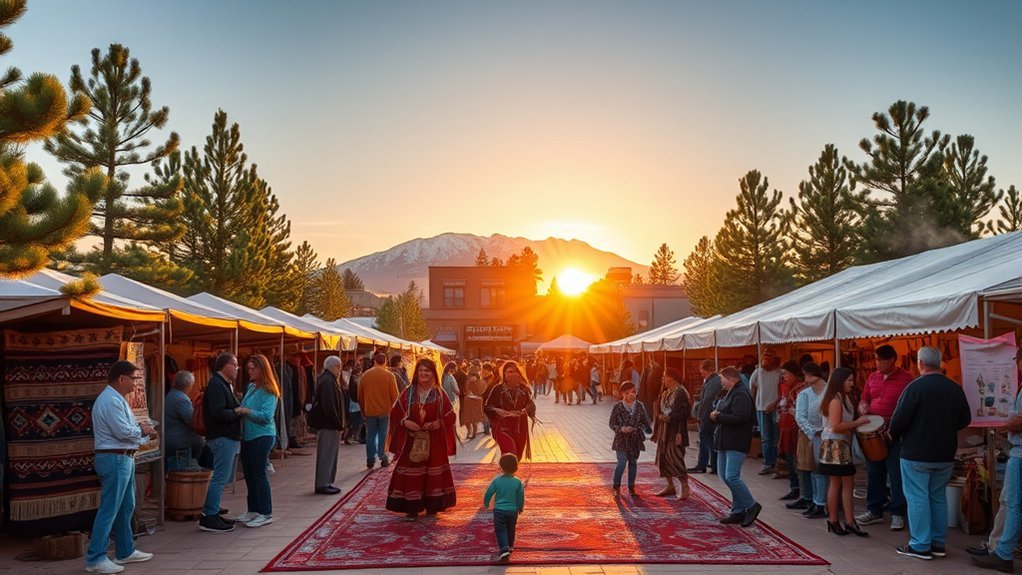
You can browse Indigenous arts markets in Flagstaff to meet artists selling jewelry, pottery, textiles, and contemporary work rooted in tribal traditions. Seasonal cultural festivals bring drumming, dance, storytelling, and food that reveal living connections to Hopi, Navajo, and other regional tribes. Check event calendars and ask at visitor centers so you don’t miss market days and festival schedules.
Indigenous Arts Markets
Immerse yourself in Flagstaff’s Indigenous arts markets, where vivid textiles, silverwork, and pottery connect you directly with Navajo, Hopi, and other tribal artists who share stories through their craft. You’ll find handcrafted rugs, intricate turquoise jewelry, and hand-coiled pottery displayed with explanations of techniques and meanings. Vendors often demonstrate weaving or silversmithing, so you can watch traditions alive and ask about symbols, materials, and sourcing. Bring cash, but many accept cards; be prepared to learn pricing that reflects labor and cultural value. Respectful conversation and permission before photographing are appreciated. Take home a piece that carries provenance — look for artist signatures or tags — and support local creators sustaining Indigenous arts and livelihoods.
- Browse authentic textiles, jewelry, pottery
- Watch live demonstrations and ask questions
- Buy pieces with provenance and artist info
Seasonal Cultural Festivals
When the seasons turn, Flagstaff fills with vibrant Native American festivals where music, dance, and market stalls bring tribal traditions to life; attend a powwow or harvest celebration and you’ll hear drum circles, see elaborate regalia, and find craft vendors sharing stories behind their work. You’ll stroll through grounds where families gather, elders lead blessings, and youth perform jingle and fancy dances that pulse with history. Look for event schedules at the Museum of Northern Arizona or tribal community centers — many festivals welcome visitors and offer educational talks, guided craft demonstrations, and traditional food booths. Bring cash for handmade jewelry, pottery, and textiles, and respect photography rules. These seasonal gatherings let you connect to living cultures while supporting artists and preserving ancestral practices.
Ride the Flagstaff Scenic Byway to Sunset Crater
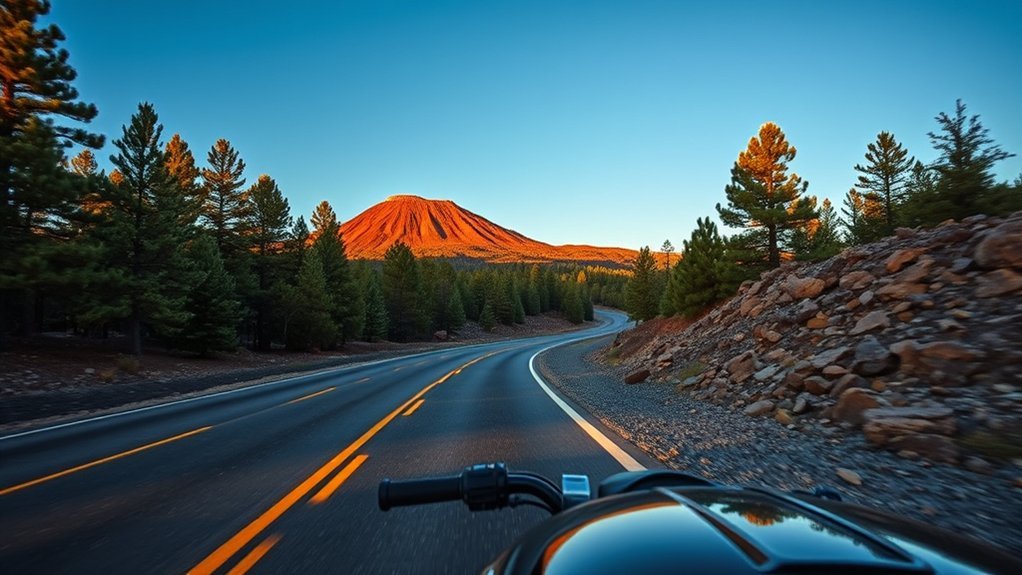
Winding out of Flagstaff along the Scenic Byway, you’ll watch pine forests open into a stark, otherworldly landscape shaped by volcanic fire. The 14-mile drive to Sunset Crater Volcano National Monument unfurls lava fields, cinder cones and sweeping vistas; pull over at overlooks to feel the scale and snap photos where light and shadow carve the cones. Interpretive signs explain eruptions from a thousand years ago and the ways native peoples adapted to the ash‑studded terrain. You can stop at the visitor center for maps, ranger tips and short trail suggestions.
Winding out of Flagstaff, the 14‑mile Scenic Byway opens to lava fields, cinder cones and sweeping volcanic vistas.
- Stop at Lenox Crater overlook for panoramic views and easy photo access.
- Hike the gentle Lava Flow Trail to walk across hardened black basalt and small lava tubes.
- Visit the visitor center to learn eruption history, pick up trail maps and get seasonal trail conditions.
Drive slowly, plan for changing weather, and bring water — the route rewards a patient pace with striking geological storytelling.
Explore Fort Tuthill County Park and Events
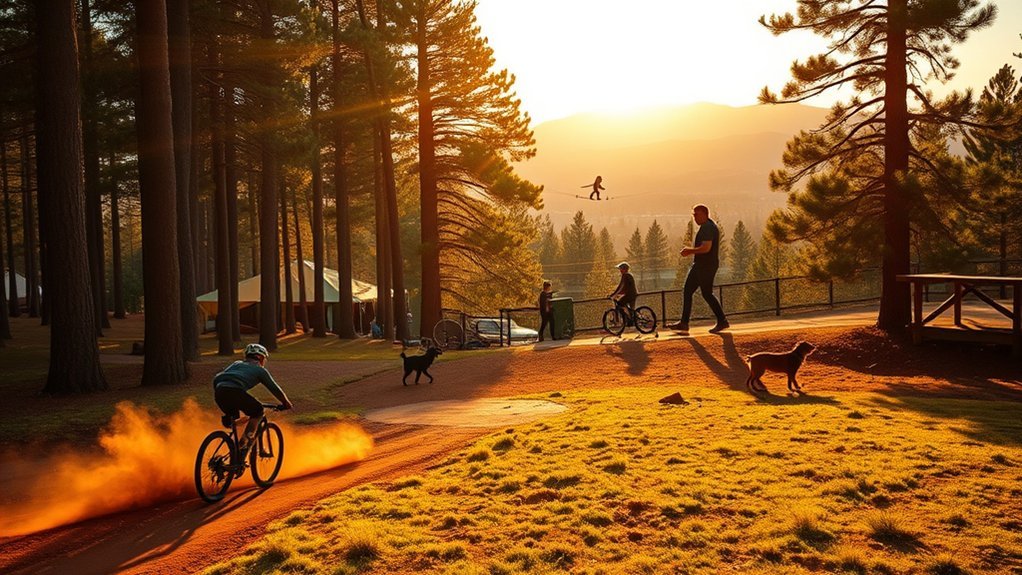
Step into Fort Tuthill County Park and you’ll find a lively hub where outdoor fun and community events collide against a backdrop of Ponderosa pines and open fields. You can stroll shaded picnic areas, follow winding multiuse trails, or let kids loose on playgrounds while you watch hawks drift above. The park hosts seasonal festivals, farmers markets, and the county fair—check the calendar so you don’t miss concerts, craft shows, or community races. If you’re into biking or running, mapped loops vary from gentle to challenging, and rental options or guided programs pop up during event weekends. Historic buildings and interpretive signs give a sense of local heritage without slowing your adventure. You’ll appreciate clean restrooms, ample parking, and reservable pavilions for group gatherings. Whether you want a peaceful nature break, family-friendly activities, or an energetic event-filled afternoon, Fort Tuthill delivers accessible, well-maintained spaces that suit a wide range of plans and abilities.
Try Rock Climbing at Lewis and Clark Trail Areas
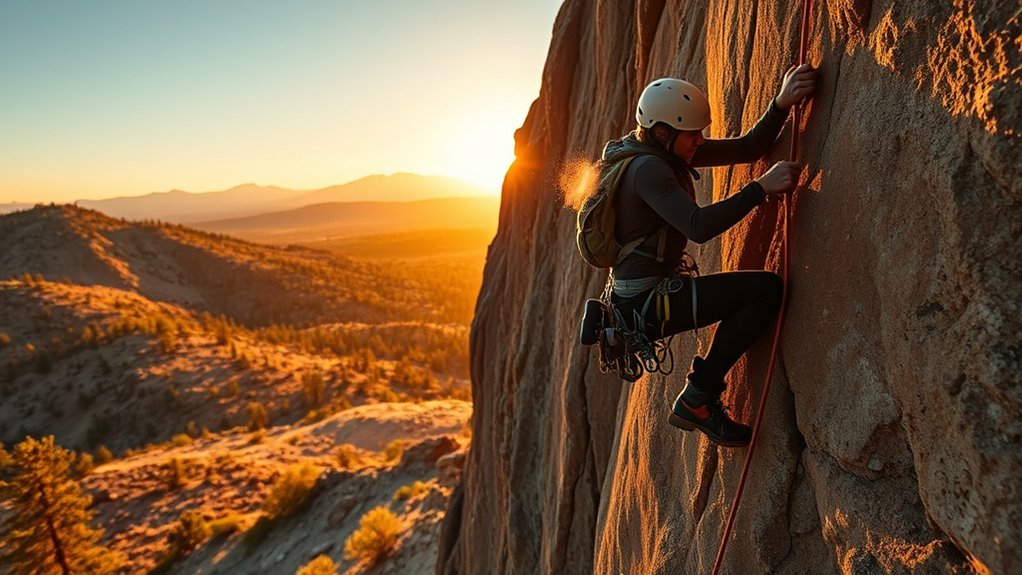
Head out to the Lewis and Clark Trail areas for a compact, rewarding climbing experience that suits beginners and seasoned climbers alike. You’ll find varied volcanic rock faces, short approaches, and routes ranging from easy top-ropes to challenging sport pitches. The crags sit among ponderosa pines, so you get shade, views, and a quiet atmosphere without long hikes. Local guide shops offer rentals and lessons if you’re new or want a refresher; they’ll set anchors, teach belay technique, and point you to climbs that match your level. Pack water, sunscreen, and a light jacket—temperatures shift quickly. Be mindful of seasonal closures for nesting raptors and practice Leave No Trace: stick to established trails, carry out tape and trash, and minimize chalk use. After a few climbs, you’ll appreciate how the Lewis and Clark areas deliver concentrated climbing with big-sky scenery.
- Pick routes rated for your skill and warm up on easier lines.
- Rent gear or hire an instructor for safer progression.
- Check closures, conditions, and weather before heading out.
Take a Photography Tour of Snowcapped San Francisco Peaks
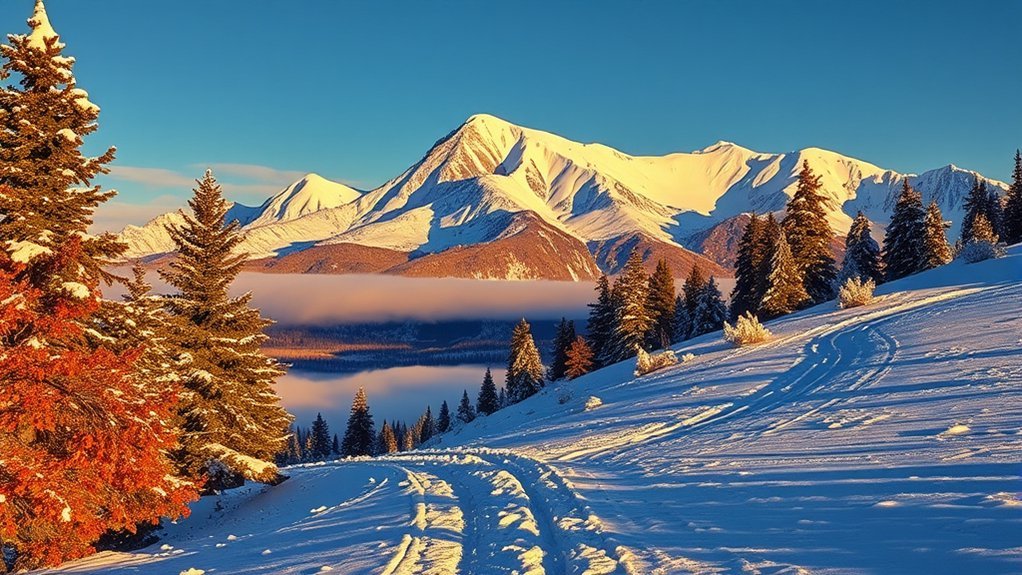
Often, you’ll find the San Francisco Peaks glowing at golden hour, their snowcaps catching color while the surrounding aspens and pines frame dramatic foregrounds—making a photography tour here rewarding for every level of shooter. You’ll scout viewpoints like Elden Lookout and Snowbowl access roads, watch light shift across ridgelines, and use foreground texture—lichen, trunks, cairns—to add depth. Bring a tripod for low-light panoramas, a telephoto for distant peaks, and a polarizer to deepen sky contrast. Read weather quickly; storms can gift dynamic skies but change conditions fast. Aim for sunrise or late afternoon, and don’t ignore micro-details: frost on needles and shadow patterns in snow tell the season’s story.
| Subject | Tip |
|---|---|
| Sunrise | Arrive early, scout composition |
| Telephoto | Isolate peak details |
| Wide-angle | Capture foreground to summit |
| Tripod | Stabilize for long exposures |
| Weather | Be ready to adapt plans |
Relax and Dine on Historic Beaver Street
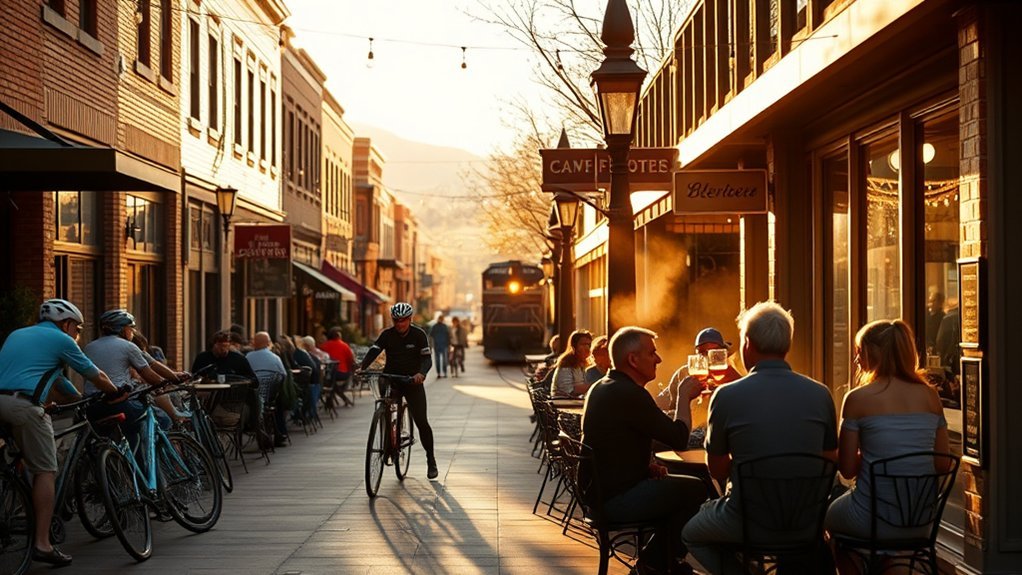
Nestled in Flagstaff’s historic core, Beaver Street invites you to unwind with tree-lined sidewalks, preserved redbrick facades, and a lineup of restaurants, cafes, and bars that blend Southwestern flavors with contemporary flair. You’ll stroll past gallery windows, pick a sunny patio, and savor everything from wood-fired pizzas to Navajo-inspired dishes paired with local craft beer or a mezcal cocktail. Live music often drifts from doorways, adding a convivial soundtrack as you sample small plates and seasonal salads. If you want a relaxed dinner, choose an intimate bistro; if you’re in a social mood, grab a seat at a bustling bar and chat with locals. Don’t miss dessert spots for housemade pastries or a late-night coffee to cap the evening. Use the street’s compact layout to hop between venues, letting serendipity guide your meals.
- Patio dining with mountain views
- Local breweries and cocktail lounges
- Bakeries, coffee shops, and dessert bars
Frequently Asked Questions
What Are the Best Months to Visit Flagstaff for Mild Weather?
You should visit Flagstaff in May, June, September, or October for mild weather; you’ll enjoy pleasant days, cool nights, fewer crowds, blooming wildflowers in spring, and brilliant fall colors, making outdoor exploring comfortable and scenic.
Are There Guided Shuttle Services From Phoenix to Flagstaff?
Imagine a coach filled with weary sunburnt tourists and one ecstatic hiker cheering at red rocks. Yes—you’ll find guided shuttle services from Phoenix to Flagstaff; private and shared operators run scheduled, comfortable trips with luggage handling and narrated routes.
Is Flagstaff Dog-Friendly on Trails and in Downtown Areas?
Yes — you’ll find Flagstaff dog-friendly trails and downtown spots, but you’ll follow leash rules, seasonal restrictions, and occasional area closures; bring water, waste bags, and check specific trail or business policies to keep outings safe and welcome.
Where Can I Find Accessible/Ada-Friendly Attractions in Flagstaff?
You’ll find ADA-friendly attractions at the Lowell Observatory, Riordan Mansion, Flagstaff Arboretum, and Museum of Northern Arizona; downtown shops and many trailheads offer accessible paths, and the visitor center can help plan accessible outings.
What Permits or Passes Are Required for Trailhead Parking?
You’ll need a valid Forest Service or city parking pass for many trailheads; some require a Coconino National Forest day-use permit or specific parking permit. Check trail signs and the Forest Service website for exact locations and fees.
Conclusion
You’ll leave Flagstaff feeling like a camera that’s finally learned to focus — after climbing Humphreys Peak at sunrise, I watched a lone junco perch on my pack and catch the light, a tiny compass of joy. Whether you’re spying cliff dwellings at Walnut Canyon, tracing Route 66, or stargazing at Lowell, those moments sharpen the map of your memories. Come curious, move slow, and let Flagstaff’s landscapes refocus what matters.

